Wagon Reviews

Toyota Rukus Build 3 2011 review
Read the article
By Chris Riley · 18 Jul 2011
WE turn the spotlight on automotive's newest and brightest stars, as we ask the questions to which you want the answers. Ultimately, however, there is only one question that really needs answering ... would you buy one?WHAT IS IT?Hmmm? Toyota's idea of funky and it ain't half bad, believe it or not. Below the skin beats the 2.4-litre heart of a Camry, but in a slightly different state of tune.HOW MUCH?Rukus prices start at $27,490, with buyers able to choose from three equipment grades known as Build 1, Build 2 and Build 3 _ our top of the line Build 3 is $31,790.WHAT ARE THE COMPETITORS?In terms of design probably the Kia Soul, but the Soul is slightly smaller and doesn't offer the same sought of power. After that, it will probably appeal to SUV buyers and those just looking for something different.WHAT'S UNDER THE BONNET?2.4-litre four cylinder petrol engine with 123kW of power and 224Nm of torque. Puts out slightly more power and torque than the Camry equivalent. Only gets a 4-speed auto compared with Camry's 5-speed.HOW DOES IT GO?Like a rocket. Punch the accelerator at the lights and it takes off like a scalded cat with a brief spin of the front wheels.IS IT ECONOMICAL?It's rated at 8.8 litres/100km but we wee getting 9.3 mainly travelling up and down the motorway. Guess that's the price you pay for the performance.IS IT `GREEN?'Gets 3.5 stars out of 5 from the Governnment's Green Guide, with a greenhouse rating of 6/10, air pollution rating 6.5/10 and CO2 emissions of 208g/km. The hybrid Prius sets the pace with 5 stars.IS IT SAFE?Gets 4 out of 5 stars. Comes with six airbags, anti-lock brakes with brake assist and electronic brake force distribution as well as electronic traction and stability control.IS IT COMFORTABLE?Not armchair comfortable but not bad all the same. The digital speedo has been moved to the middle of the dash and takes some getting used to. To the left of it is the tacho, followed by the fuel and temperature gauges in order of priority.WHAT'S IT LIKE TO DRIVE?Easy to drive and short front and rear overhangs make it easy to park. Higher driving position is not unlike an SUV. Computer lacks a touchscreen which makes the controls fiddly. Steering wheel audio controls need to be illuminated.IS IT VALUE FOR MONEY?Build 3 gets leather and climate air plus a sunroof, Bluetooth, keyless start and a 9-speaker audio including a subwoofer.WOULD WE BUY ONE?Certainly appealing. Punchy performance. Easy to park and drive. Smallish luggage area and space saver spare are turnoffs as is the 4-speed auto. A 5-speed would do wonders for the economy.
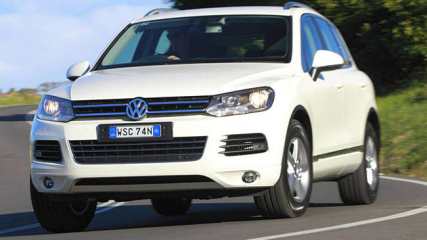
VW Touareg 2011 V6 review
Read the article
By Ged Bulmer · 12 Jul 2011
It’s been eight years since VW first introduced Australia to its new large SUV, and in that time there’s been just the one update, in 2007. Sales peaked at just over 1000 a year in 2008 but since then have fallen away dramatically, to just 27 units so far this year, largely due to supply constraints following the end of production of the old model in March 2010. The company is hoping this all-new model, on sale already for some 15 months in Europe, will revive Touareg fortunes.Unfortunately, the delay in the start of right hand drive production sees VW Australia in the uncomfortable position of launching a new model (the V6 TDI) with a diesel engine upgrade arriving almost simultaneously. Admittedly it’s only 4kW of extra power and a piddling improvement in fuel consumption on an already efficient engine, but owners taking delivery of the about-to-be-superseded V6 diesel may well take a dim view of VW’s timing.VALUEThe Touareg is based on the same underpinnings as VW Group stablemates the Audi Q7 and Porsche Cayenne, with all three made in the same Slovakian Republic factory. The substantial technical similarities between the VW and its more expensive rivals won’t be lost on astute Touareg owner.Prices start at $62,990 for the 150TDI, rise to $77,990 for both the V6FSI and V6TDI, and top out at $82,990 for the V6TDI 4XMotion. These look amd are sharp against the entry level petrol V6 Porsche at $104,000 and turbo diesel Audi Q7 at $88,614, but VW is learning to play the options game almost as astutely as the ‘true’ prestige German brands, with the result that a fully kitted out V6TDI 4XMotion checks out at an eye-watering $116,690.Having said this, a similar level of equipment on any of the VW’s prestige rivals would no doubt serve only to emphasise the Touareg’s price advantage.On top of those base prices there are a range of option bundles including the $1000 Sports Interior (multi-function leather wheel, paddleshifts, alloy pedals, tinted glass); the $4500 Comfort package (four zone climate control air-con, climate control front seats with memory, heated leather electrically adjustable wheel); and $5400 Driver Assistance Package (adaptive cruise control, lane change assist, lane departure warning system, proactive occupant protection).An eight-inch touchscreen sat nav system is standard on the top three models but a $4900 option on the 150TDI.TECHNOLOGY There are three engines: two 3.0-litre turbo-diesel V6s that are identical but for their state of tune, and a 3.6-litre direct-injection petrol V6. All are Euro 5 compliant and they’re spread across a four model range: 150TDI,V6FSI, V6TDI and V6 TDI 4xMotion.The diesels feature VW’s BlueMotion clean diesel technology which includes thermal engine management for cleaner combustion, brake energy recuperation, and start-stop system. The petrol V6FSI also gets stop-start.Interestingly, there’s no automatic reverse parking function, despite it’s availability on the smaller and cheaper Tiguan. VW says its optional ‘Area View’ system, when coupled with front and rear parking sensors and rear-mount camera is sufficient reassurance for most drivers.Area View utilises a quartet of wide angle cameras in the front, rear and sides of the vehicle to give the driver an all-round view of the vehicle surrounds.It’s clever tech that, among other things allows a driver to effectively see around corners when exiting driveways, while also helping avoid kerbed wheels and other parking mishaps. Cost is $1100 for the top three models and $2500 for the base 150TDI.SAFETY Neither the European or Australian safety authorities have yet crash tested a Touareg but given the previous model achieved a five star rating, and this car is claimed to be five per cent torsionally stronger and has more safety features, it’s safe to assume it’ll also achieve the top ranking.That extra strength is no small feat, especially when considered against the new body also being five per cent lighter. VW claim to have pulled a maximum of 90kg out of this new model, despite it being slightly bigger in all key dimensions and packing plenty of extra tech. No doubt that’s an optimised figure and some models will come in heavier but it’s still laudable. Lighter doors and tailgate, aluminium suspension components and the adoption of an electronic park brake have all contributed to the weight loss.4Motion constant all-wheel drive is standard on three models, with the more off-road oriented V6 TDI 4XMotion a permanent ‘four-wheel drive’, with transfer case and low-range gearing, electrically lockable centre and rear differentials, under body protection and a 15-litre larger fuel tank to give it a 100-litre capacity.Nine airbags are standard as is antiskid brakes and a raft of related safety features such as Electronic Brakeforce Distribution, Brake Assist, and stability control. There’s also hill descent control for off-road driving, hydraulic brake assist, which automatically applies extra braking pressure in an emergency stop, roll-over protection and automated engagement of the hazard lights.Adaptive Cruise Control is the major party trick in the Touraeg’s safety and convenience kit. The system utilises cameras, radars and sensors to not only automatically raises and lower vehicle cruise speed according to traffic conditions, but to also alert the driver in the event of an accident or obstacle ahead. Should the driver fail to react the system pre-tensions the seatbelts and activates the hazard lights before initiating emergency braking.When tied in with other systems such as Lane Assist, which uses the same camera technology to effectively ‘read the road’, sending a signal through the steering when the vehicle strays out of its lane, the correctly optioned Touareg make for a formidably safe driving experience.Under the cargo bay floor there’s a space saver spare and no option for a full-size, so anyone wanting to get properly adventurous will need to allow for that.STYLING In true VW style the new Touareg is an evolutionary restyle of the original. There’s a clear familial resemblance that means you instantly identify the low and wide stance of the new model, but there’s also been enough change to not mistake new for old. The 2011 model adopts VW’s new corporate face with strong horizontal grille bars, prominent central badge and large fluted air intakes beneath each headlight. The headlights themselves are now more distinctive thanks to LED daytime running lights and the vehicle overall is handsome and well finished, exuding a sense of strength and capability.The base 150TDI rolls on 255/60R17 wheels and tyres, the others on 255/55R18s, with a 20-inch wheel option available for $4900.Boot space is a commendably large and accessed by a new automatic electric tailgate, the opening height of which can be tailored for different garages. As with the Tiguan, the sliding second row of seats can be adjusted to create more boot space, which in standard configuration comes in at 580 litres seats up and 1642 litres seats down. Buttons in the luggage area allow the rear seat backs to be folded automatically and, if you add the $5900 air suspension you can also adjust the load height via buttons in the luggage area.DRIVING The optional air suspension system comes with three drive modes, Normal, Sport and Comfort which alter the vehicle’s ride comfort and, in the case of Sport, lowers the ride height for improved handling.We didn’t try it but did sample a $77,990 V6TDI with metallic paint, Sports Interior and Bi-Xenon headlights, that tipped the recommended retail scales at $83,990. The car proved superbly quiet on road, the extra gear ratios allowing an extra tall eight gear that registers a relaxed 1500rpm at 100km.Improvements to the cars aerodynamics have also contributed to the sense of calm inside the cabin. Despite this, there’s strong off-the-mark and mid-range acceleration from the up-spec diesel, which combines to deliver mostly seamless shifts up and down the ratios of the eight speed auto. Slowing for roundabouts did catch it out a couple of times, however, the gearbox clunking a little awkwardly into a lower gear and the turbo pausing for a moment to gather its skirts, but these were exceptions to an otherwise very refined drive.The steering is decently weighted though not notable for its Porsche-like feel, and body control is up to the task in all but real press-on driving conditions, where the high centre of gravity leads to moderate body roll.The driving position is good and the cabin comfort excellent, although there’s a bewildering array of buttons on the steering wheel, wands and centre console that takes time to master.VERDICT With its refinement, efficient engines, eight speed auto, and fundamentally sound active and passive safety systems, the Touraeg makes a compelling case for anyone in the market for a safe and sophisticated large SUV. It’s sized right to fit most families, although the lack of a seven seat option will no doubt exclude it from some shopping lists. In base trim across the model range it provides an intriguing European alternative to the host of mid to large Japanese and Korean SUVs on our roads, while the extensive options list allow those with prestige aspirations to order up a specification level that won’t look out of place in a prestige showroom.SPECSPrices: 150TDI $62,990; V6FSI $77,990; V6TDI $77,990 ; V6 TDI 4XMotion $82,990.Warranty: 3 years, unlimited kilometresResale: N/AEngines: 3.0-litre V6 turbodiesel, 150kW @4000 rpm/400Nm @ 2000rpm; 3.0-litre V6 turbodiesel; 176kW @ 4000rpm/550Nm @ 2000rpm; 3.6-litre FSI petrol; 206kW @6200rpm/360Nm @ 2900-4000rpmThirst: 150TDI 7.6L/100, 201gCO2/km; V6FSI 10.1L/100km, 240gCO2/km; V6TDI 7.6L/100km, 201gCO2/km; V6 TDI 4XMotion 7.7L/100km, 202gCO2/kmWeight: 2097kg to 2222kgDimensions: LxWxH 4898mmX1965mmX1732mm; Wheelbase 2904mmTransmission: Eight speed automaticBody: Five door five seat wagonTowing Capacity: 3500kg braked; 280kg towbar downloadOPTIONS GALORE Metallic/Pearl effect paint $1500Panoramic Electric glass sunroof $3000Sat Nav system $4900Anti-theft alarm $900Dynaudio 620W premium audio $900Bi-Xenon headlights with dynamic cornering lights and LED daytime running $3500Driver Assistance Package $5400Area View (150 TDI) $1100Comfort Package $4500Sports interior $100020-inch alloy wheels $4900Air-suspension $5900ODD SPOTThe Touareg’s integrated automotive hard disc has 60GB of storage volume and can even tell whether you need to top up your oil or not. A menu in the infotainment system allows you to run a check on the engine oil level thanks to an oil sender that relies on the same principles as ultrasound.
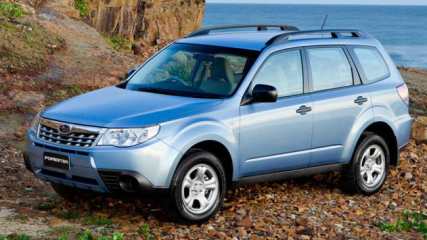
Subaru Forester X 2011 review
Read the article
By Chris Riley · 11 Jul 2011
Whatever Subaru's game plan is, it seems to be working. Sales are up despite the fact that the cars are more generic than ever, with design that ranges from the sublime to the ridiculous.The Forester is a good case in point. Over the years it has morphed from a knockabout, all-wheel drive station wagon into a just another high riding, roly-poly SUV.Be that as it may, earlier this year, Forester became Subaru's biggest selling model of all time, eclipsing even the Impreza — with sales in excess of 150,000 since launch in 1997.It comes as no surprise then that Forester leads the fiercely contested SUV segment in Australia and has done for the past three years.For whatever reason, it has struck a chord with buyers.But one wonders whether time is running out for the niche Japanese car maker, with its "symmetrical" all-wheel drive mantra.The thing is, all wheel drive is starting to lose some of its gloss, with electronic braking systems able to achieve the same level of safety these days.And you end up paying more for all-wheel drive at the pump, because driving all four wheels all the time by necessity pushes up fuel consumption.Having got that off my chest, I'd like to now sing the praises of the new Forester and its new third generation 2.5-litre boxer engine.It might have lost some of its character, but the new model distinguished by a new front grille exudes a real feeling of quality and is a pleasure to drive, with a sporty spring to its step thanks to the Boxer engine.TECHNOLOGYThe new FB engine which makes its debut in the Forester offers no additional power but there has been a small increase in torque.The flat four definitely feels more refined and responsive and the switch to chain drive means no more cam belts to replace.The new engine, the first completely new design in 21 years, puts out 126kW of power at 5800 revs and 235Nm of torque at 4100 revs, with 0-100km/h taking 9.2 seconds.Fuel consumption is rated at 9.3 litres/100km, compared to the previous model's 9.6 litres (we were getting 9.8).Sadly, however, while the engine might be new, we're stuck with the same old five-speed manual or four-speed automatic transmissions, although we're told the auto has been improved.The rest of the world has moved on.Our test vehicle, the base model Forester X with a five-speed manual, has dual range gearing (low and high range).DRIVINGThe engine sounds fabulous and the ride is exemplary, but pushed hard the wagon with its higher centre of gravity exhibits plenty of body roll.Corners taken at speed will spark an extreme reaction from the electronic stability control system.Low range is handy for slippery boat ramps and the like, but off road the Forester can get further than you think in the hands of an experienced driver, with 220mm of ground clearance.Steel wheels are standard fitted with 16 inch Bridgestone 215/65 Duellers and a full sized spare wheel is provided.Inside you get cloth trim and manual airconditioning, but it lacks outlets for rear seat passengers.The dash include a darker finish and darker tone metallic-type highlights for enhanced appearance.Cabin noise levels are reduced through use of an enlarged, higher density, under bonnet noise insulator.Bluetooth is also standard and there's a 12 volt outlet plus AUX and USB ports in the centre console box, with controls for the phone and audio mounted on the wheel.AT A GLANCEPrice: from $30,990Warranty: 3 years/ unlimited kmSafety: 5 star ANCAP2 occupant safety rating , Symmetrical all-wheel drive, ABS, EBD,VDC, SRS Airbags – dual front, dual front side and curtain, Active Head Rests.Engine: Horizontally-opposed Boxer 4-cylinder, petrol engineBody: 5-door WagonTransmission: 5-speed manual transmission, 4-speed automatic transmission with manual mode.Thirst: 9.3L/100km, CO2 220g/km
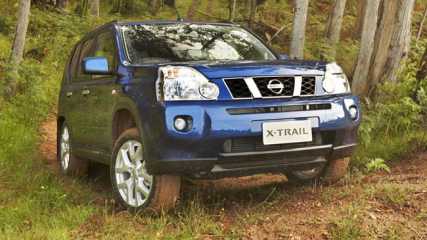
Nissan X-Trail ST-L 2011 review
Read the article
By Peter Barnwell · 27 Jun 2011
WE turn the spotlight on automotive's newest and brightest stars, as we ask the questions to which you want the answers. Ultimately, however, there is only one question that really needs answering would you buy one?WHAT IS IT?This is the recently introduced X-Trail ST-L front wheel drive for people who don't want or need all wheel drive. It uses a Nissan Dualis engine and transmission. You can get a lower spec' manual version called the ST for under $30KHOW MUCH?$34,990 plus on roads.WHAT ARE THE COMPETITORS?Mitsubishi Outlander fronty, RAV4 fronty, Mazda CX7, Kia Sportage, Hyundai iX35 and plenty more.WHAT'S UNDER THE BONNET?Gets a twin cam, petrol 2.0-litre, four cylinder with 102kW/198Nm output drinking regular unleaded. Drive goes through a Constantly Variable Transmission (CVT).HOW DOES IT GO?OK but sometimes feels as it there's a sock in the exhaust until you floor the accelerator. Alternatively you can use a button on the gear selector to slip down a ratio for better acceleration. Gets off the line OK, not too noisy, willing once you get going. OK an around town practical wagonIS IT ECONOMICAL?Not particularly. Nissan says 8.4 litres/100km for the CVT ST-L. We got 10.1 in mostly highway driving and some inter-urban commuting — the same as a much bigger Ford Territory petrol rear wheel drive we we had at the same time.IS IT `GREEN?'Rates 6.5 in the Green Car Guide.IS IT SAFE?Will rate four ANCAP stars.IS IT COMFORTABLE?Yes, but the seat backs need more support even with the lumbar adjustment wound right up. The boxy body translates into plenty of room for five adults if necessary. ST-L grade scores plenty of kit like remote central locking, climate control, drive computer, leather upholstery, electric adjust and heated front seats, multi function wheel, 17-inch alloys, Bluetooth phone and privacy glass.WHAT'S IT LIKE TO DRIVE?Not too bad actually — bit tardy to respond to throttle input on the highway especially uphill but then it does weigh 1444kg and runs a 2.0-litre petrol engine. Wouldn't like to be in it with five adults and luggage with the air on. Ride is comfy and relatively well controlled, has strong brakes, minimal noise intrusion and high driving position.IS IT VALUE FOR MONEY?About on the money but we'd push for a sharper price given the competition.WOULD WE BUY ONE?Probably not, we'd go for the diesel auto first — a much better proposition but only available in 4x4 so you pay more.
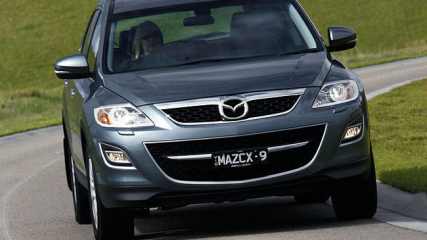
Mazda CX-9 2011 review
Read the article
By Neil Dowling · 16 Jun 2011
VIRILITY was once established by a man's courage in the face of death. Fighting a lion using nothing but his bare hands was one early test, halted when the villages realised they were quickly running out of men.A more sophisticated civilisation softened the need to pursue wildlife, replacing it with the ability to croon to a theatre packed with women. This was replaced by the ability to make lots and lots of money.Which brings me to seven-seat wagons. Clearly, a bloke driving around in one of these says more about his reproductive potential than that of Tarzan, Bing Crosby and Donald Trump.And let's not be sexist. A woman driving such vehicles is telling the world more about her desires behind the wheel than wearing a T-shirt imprinted with "Child Rearer".But what seven-seat wagon has the style to pull it off? This one.Seven seat wagons generally aren't cheap because they're made with a lot of metal and fabric. The Mazda CX-9 comes in three versions priced from $50,015.Tested is the Luxury at $57,015. It's about $11,000 above the five-seat Mazda CX-5 and basically adds more room, more seats and a bigger engine - though no diesel option.It is a serious end of the market. Children aside, bigg-ish SUVs like the CX-9 are loved by outdoorsy people, even those that don't go outdoors.The wagon must be flexible, roomy and with the ability to have a decent tow rating. The CX-9's enemy includes the new Ford Territory, now with the option of a diesel engine. I'd be carefully doing my sums before making judgement.This is a good looking wagon with a big smiley face. It follows the design of the smaller CX-7 and yet doesn't look like an awkward stretch job. More a 110 per cent enlargement. The extra 406mm length allows a third row of seats suitable for two small people. Trust me, if you're an adult you will not be comfortable back there.Boot space shrinks, naturally, to the point where not much more than a suitcase will slip behind the third row of seats. But it's great for family and friends and the versatility of the seating - the centre row is on sliders - gives it a purpose for almost every occasion.Lots of leather and an attractive dashboard is spoilt only by so-so sat-nav graphics and the foot-operated park brake. The rest is great.Not rocket science - a 3.7-litre 204kW/367Nm V6 petrol and all-wheel drive oily bits under an attractive body. It's a well executed and pleasantly simple package.Actually, the wagon is a front-wheel drive and will only start sending power to the rear wheels when needed - for example, when the front wheels slip on a wet surface or during heavy-footed acceleration.Theoretically, you could venture off the bitumen and gravel but reality says this is not intended to compete with 4WDs and besides, I wouldn't want to dig its 2-tonnes out of beach sand.Interestingly, the Toyota Kluger is near identical in spec and market but has almost four times the CX-9's sales - and there's no logical reason for this disparity.Mazda scores a maximum five-star rating for practically all its cars and the CX-9 is no exception.It also adds all the necessary electronic nannies, including ESC, ABS and rollover mitigation. Plus it's tall and looks like it wouldn't dint against a Mack.Yes, it's big but it has a confidence about it that creates the impression it is nimble.The steering is nicely weighted - though there's a bit too many turns lock-to-lock - and the automatic transmission puts down the cogs quickly and without fuss.The V6 engine is silky smooth and willing to rev with a good dab of torque at low revs - about 330Nm is available from 2800rpm - which makes it pointless to scream it out to 6250rpm to find the 204kW of power.Handling is secure though pushed hard will unleash understeer (the car wants to keep going straight ahead during a corner) and body roll. But it is so comfortable and quiet that you lose the desire to drive it quickly. It is, of course, a wagon for lots of people or luggage.

Used Chrysler 300C review: 2005-2011
Read the article
By Ewan Kennedy · 16 Jun 2011
Chrysler 300C is a big, bold, very American machine with aggressive styling that explains its nickname of ‘the gangster car’.

Mercedes-Benz C-Class 2011 review
Read the article
By Peter Barnwell · 01 Jun 2011
How do you make a good thing better? This would have been the challenge at Mercedes-Benz when developing the mid-life makeover for the current generation C-Class, Merc's most popular car.They attacked the problem on a number of fronts tweaking the looks with more angular CLS-style headlights and sporty frontal and rear styling treatment. They introduced BlueEfficiency measures across the entire range to optimise fuel economy and minimise emissions. They introduced a seven-speed auto across the range and two new diesel engines one with an incredible 500Nm output from a "mere" 2.1-litre four cylinder.Putting this into perspective, many current V8 petrol engines struggle to generate that amount of grunt. Further aiding emissions reduction is the use of engine stop/start and "eco" driving "tuition" on the diesels. Mercedes also took the opportunity with this model to introduce a raft of new safety and luxury technology, some of which is standard equipment, some in packages and some as stand alone options.Distronic Plus radar cruise control is one such option as is active lane keeping which brakes one side of the car to steer it back into a lane if the driver strays. Aluminium is used more generously in the new car for the bonnet, front guards and suspension components while LED front driving lights and tail lights also make an appearance.Prices start from $58,900 for the C200 petrol sedan, two grand more for the wagon across the range.The interior has been comprehensively redesigned with a more homogenous look that flows from one side to the other and integrates the switches and dials more successfully. A new telematics platform is used offering more functions and easier operation.A new steering wheel contains up to 12 control buttons for audio, cruise control, information, oh, and the horn. More attractive "galvanised" fascia adorn the interior which is easier to use and looks a lot better than before.Safety is well addressed with nine airbags a slew of electronic controls/systems designed to either minimise injury or avoid a collision. Pre-safe which readies the car for a crash to offer maximum passenger protection is standard in all models. Pre-safe brake will automatically apply up to 100 per cent of possible brake force to mitigate an impact.Fuel economy across the board has improved in both turbodiesel and turbo petrol engines. The most efficient is the 500Nm CDi250 which achieves a combined rate of 5.1-litres/100km. Other engines aren't far behind including the 1.8-litre turbo and direct injection petrol four cylinder models. All engines meet Euro 5 emissions regulations due to come into force here in a few years.In luxury terms, the revised C-Class doesn't miss out with plenty of electronic communications and entertainment technology making an appearance including a 40 gigabyte hard drive for the satnav and audio system which has audio streaming.The satnav system is linked to a dynamic guidance system and audio broadcast facility provided by SUNA. It will advise of traffic problems and reprogram your route to avoid it - clever.We tried sedan and wagon variants of all four cylinder powertrain options and really enjoyed the C250 petrol turbo four the most. It is a compact sporty car offering superb ride and handling in a comfortable and stylish package. Performance is strong. The high output diesel, infact all the four cylinder powered cars we drove, were engaging and comfortable. We can't imagine what the six cylinder petrol and diesel must be like...
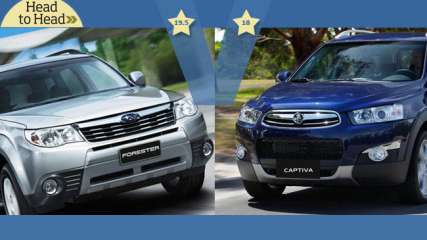
Subaru Forester X vs Holden Captiva
Read the article
By Bruce McMahon · 30 May 2011
Subaru Forester X and Holden Captiva go head-to-head in this comparative review.
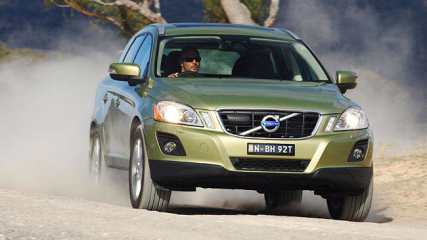
Volvo XC60 T5 2011 review
Read the article
By Neil Dowling · 19 May 2011
FORD'S F-150, a staple diet for truck-mad Americans either hauling loads or thinking about hauling loads, is trimming its muscles.It’s 5-litre V8 engine - once as popular as hotdogs at a baseball game - has hit the skids and two V6 engines are becoming the powerplants of choice.Unprecedented? Yes. Predictable? Yes, given that this is the era of downsizing to scavenge back fuel consumption and reduce exhaust emissions.The fact that Ford's most popular model is doing it - and doing it successfully - confirms that small engines are here to stay. No surprise that others are doing something similar.The latest Volvo SUV, for example, is a 1.8-tonne family wagon now with the option of a 2-litre four cylinder. Intriguingly, it drives only the front wheels.That gives you an SUV with no off-road ability yet all that genre's versatility, practicality, safety and high-ride attitude. To boot, it's cheaper to buy, run and maintain than its 4WD sister models.VALUEThe Volvo XC60 T5 costs $54,150 which is the cheapest on the XC60 foodchain and a good $3500 more affordable than the next cheapest - the slower, thirstier and heavier all-wheel drive 3.2 version with a six-cylinder petrol engine.If you're not planning a trip to the outback or even a lazy spin on the beach, then opting for the T5 is clearly a no brainer.The feature list of the T5 is also identical to the 3.2 and the only real difference is the latter's 2000kg tow rating, up 200kg on the T5.There is a temptingly huge - and not inexpensive - option list available so be careful you don't exceed your budget.Going 2WD in the prestige end of the SUV segment isn't uncommon so Volvo hasn't got the playground to itself.However, in comparison with most, it is cheaper, offers better value (the two aren't necessarily mutually exclusive), has the best safety list and I reckon better suits families, especially those with young children.DESIGNChanges to its front end has slimmed down the nose and brought it more in line with the pretty styling of the S40 and S60 passenger car models.That softens the bulky dimensions of the wagon and, combined with the elongated "S" of the tail lights, give distinction to the Volvo.Inside it's a bit more conventional but full marks to the simplicity of the dashboard and the useful storage spaces.There's a lot of thought put into making this car work for the family. Best is the two booster seats on the back seat. Better, there's two heights for kids of different sizes.TECHNOLOGYI'll labour the point - the 2-litre turbo-petrol engine in this is the same as in the Volvo S60 and upcoming Ford Falcon. It's also in other offshore things, like the new Ford Explorer SUV.It's a great powerplant and, with 177kW, will make a lot of people think twice about believing that big engines are best.Part of its appeal is the smoothness, rapid shift speed and almost lag-free action of the dual-clutch transmission. Some rival companies with similar boxes should use the Volvo unit as a benchmark.The rest of the machine is simple - MacPherson front suspension with multi-links and coils at the back, electric-assist power steering and fat disc brakes.It's good to see that the suspension is the same as the all-wheel drive models rather than pick up a comparatively crude - and cheaper - torsion beam system.SAFETYCity Safety is the system that, at low speeds, will stop the car from running into something up ahead. That could be another car, a tree, a wall or even a person.It's standard on the XC60 range. That alone puts this SUV ahead of its rivals. Then you add the full suite of electronic chassis and brake aids, a five-star crash rating and six airbags.You will have to pay $1275 for the blind-spot warning system and an extra $4175 for pedestrain alert, auto brakes on the adaptive cruise control and a queue alert when cruising busy highways. You've probably just busted your budget.DRIVINGYou'd be hard to pick this as a front-wheel drive wagon. Yes, there are times through sweeping bends where you may feel some lightness from the back end, but it's controllable and even if you stuff it up, the stability control will bring the car back on track.Though the engine is spirited, the XC60 isn't the vehicle for a fang through the hills. But I did it anyway.The biggish steering wheel is the only hinderance to the sports nature of the engine, slowing the steering reaction down and making the driver work the wheel a bit harder than a sedan.Manually picking up the six ratios gets a bit extra performance out of the engine and when downshifting, helps to slow the vehicle. But unless you're really in a hurry, the auto mode requires no effort and is almost as satisfying.The wagon is pretty big - something you feel on the road - and if it wasn't for park sensors could be awkward to park. Volvo provide big seats with wide-grain leather upholstery that is comfortable and durable. Remember that leather can repel lots of natural toxins that children tend to emit but it needs cleaning and moisturising to keep it supple.The XC60 is always comfortable, always quiet - the exception is under hard acceleration - and feels rock solid on the road.The lack of a full-size spare is annoying but given this is a city car, is not as crucial as a 4WD.VERDICTSafety sells and safety in an affordable SUV is even better. This is one of the best SUVs around and it's one of the cheapest. Win-win.AT A GLANCEVOLVO XC60 T5Price: $54,150Warranty: 3 years, 100,000km, roadside assistResale: 69% Service Interval 15,000km or 12 monthsEconomy: 8.7 l/100km; 207g/km CO2Equipment: six airbags, City Safety, ESC, ABS, EBD, EBA, TC.Crash rating: 5 starEngine: 177kW/320Nm 2-litre turbo-petrolTransmission: Six-speed dual-clutch autoBody: 5-door, 5 seat, wagonDimensions: 4627 (L); 1891mm (W); 1713mm (H); 2774mm (WB)Weight: 1740kgTyre size: 235/65R17Spare tyre: Space-saver
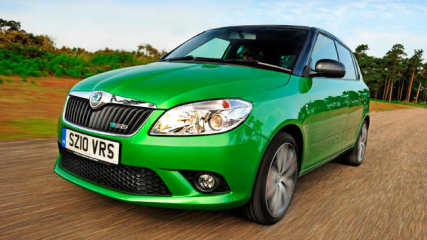
Skoda Fabia RS 2011 Review
Read the article
By Neil Dowling · 10 May 2011
A fiery Czech, with links to Volkswagen's top-rated Polo GTI, is joining Skoda's small-car invasion. But while the 132kW Fabia RS shares the Polo's underpinnings, Skoda broadens its appeal by offering it in two body styles - a hatch and a wagon - and plans a February debut in Australia.It's a fresh face for Australia but its arrival will be eased in September by cheaper Fabias - the 77kW Fabia hatch which has two models; the entry-level for about $18,000 and a special edition Monte Carlo, wearing all the hot-hatch clothing of the RS, for about $22,000.These two arrive only with manual transmissions with Volkswagen's DSG auto following in the new year. The RS, like the Polo GTI, is only available with DSG.VALUESkoda Australia claims up to a 10 per cent discount to a similar product from Volkswagen. Based on the Polo GTI's $28,990 entry, it means the Fabia RS five-door hatch could hit Australian showrooms as low as $26,000 and less than $28,000 for the roomier wagon.That's good buying for a four-seat car that goes like stink and looks the part as well. Knowing it's a GTI under the skin won't affect street cred by those who know, but down the road you have to ask if used car values won't favour the near identical Polo.Regardless, the Fabia looks good, has all the features and is a great drive for the price.DESIGNSkoda says it has the upper edge by delivering the RS in two body styles. True, the wagon adds more centimetres to boot space and will mix it in the wild world of family duties quite well.The wagon also looks less blunt in styling. The extra length over the rear wheels - the wheelbase is the same as the hatch - nicely smooths out the shape of the tail.Inside, cabin treatment is very good though the hard plastic dash top shines in the sunlight and doesn't look properly finished where it meets the dashboard's soft-feel vertical surfaces.Squeeze your eyes almost closed and the cabin is Polo. The difference is in the detail.TECHNOLOGYAgain, like the Polo, the 132kW turbocharged-supercharged engine behind the fluted grille does a stirling job. It's to be expected. The same applies to the DSG, steering and suspension which is Polo, Polo and Polo.Given that Carsguide last year gave Polo top honours as Car of the Year, it's all premium stuff.SAFETYSix airbags, electronic stability control and a five-star crash rating is all great news in a small car. The full-size spare wheel is a bonus.DRIVINGIf all the data says Polo, it drives like a Polo. Yes? No. The car feels less flighty and that can be attributed to the choice of tyres - 205/40R7 Continentals - and perhaps some extra weight, suspension tuning and maybe a bit of tweaking to the power steering unit.The ride is firm but not choppy. It is better in terms of compliance than the Polo GTI which, by comparison, is harsh. This is the RS's biggest surprise - it rides like a bigger car and there's a suppleness that is unlike rival small cars.Yet all this doesn't appear to greatly affect handling. It can, when pushed hard, carry itself into a corner with a bit more understeer than its sibling, the RS hatch. But it is such a controllable car with precise steering so minor errors made when the road curves can be adjusted quickly.Seating is sufficient roomy though some heavier Australians may not initially like the traditional narrow Skoda seats. On the road it is remarkably sprightly. The engine will yell all the way to the 7000rpm redline but never shows malice.It is a smooth, very responsive engine that, if driven with less haste than me, could produce some remarkable fuel economy figures.The street roads in the Czech Republic, where this test was held, contain a lot of cobblestones - both the old stone rounded type and the new-wave blocks of granite. The tyre noise and the jarring is awful and even a Czech-built car isn't immune.VERDICTSharing with one of the world's greatest small cars doesn't hurt Skoda one bit and the price discount will do a lot for the brand name in Australia. But is the price discount worth it?SKODA FABIA RS WAGONPrice: est. $28,000Engine: 1.4-litre, 4-cyl petrol super-turbo, 132kW/250NmBody: 5-door wagonWeight: 1373kgTransmission 7-speed DSG, front driveThirst: 6.2L/100km, 98 RON, CO2 143g/kmWarranty: 3-years/unlimited kmService Interval: 15,000km/12 monthsSafety: 5-star Euro NCAP




